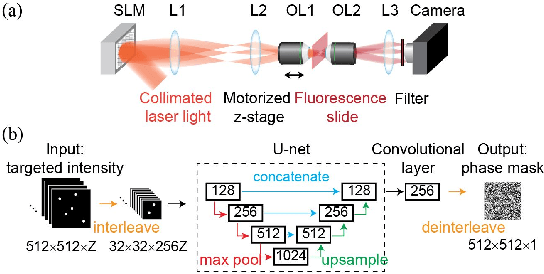Yi Xue
Compressive Fourier-Domain Intensity Coupling (C-FOCUS) enables near-millimeter deep imaging in the intact mouse brain in vivo
May 27, 2025Abstract:Two-photon microscopy is a powerful tool for in vivo imaging, but its imaging depth is typically limited to a few hundred microns due to tissue scattering, even with existing scattering correction techniques. Moreover, most active scattering correction methods are restricted to small regions by the optical memory effect. Here, we introduce compressive Fourier-domain intensity coupling for scattering correction (C-FOCUS), an active scattering correction approach that integrates Fourier-domain intensity modulation with compressive sensing for two-photon microscopy. Using C-FOCUS, we demonstrate high-resolution imaging of YFP-labeled neurons and FITC-labeled blood vessels at depths exceeding 900 um in the intact mouse brain in vivo. Furthermore, we achieve transcranial imaging of YFP-labeled dendritic structures through the intact adult mouse skull. C-FOCUS enables high-contrast fluorescence imaging at depths previously inaccessible using two-photon microscopy with 1035 nm excitation, enhancing fluorescence intensity by over 20-fold compared to uncorrected imaging. C-FOCUS provides a broadly applicable strategy for rapid, deep-tissue optical imaging in vivo.
Fluorescence Diffraction Tomography using Explicit Neural Fields
Jul 23, 2024



Abstract:Solving the 3D refractive index (RI) from fluorescence images provides both fluorescence and phase information about biological samples. However, accurately retrieving the phase of partially coherent light to reconstruct the unknown RI of label-free phase objects over a large volume, at high resolution, and in reflection mode remains challenging. To tackle this challenge, we developed fluorescence diffraction tomography (FDT) with explicit neural fields that can reconstruct 3D RI from defocused fluorescence speckle images. The successful reconstruction of 3D RI using FDT relies on four key components: coarse-to-fine modeling, self-calibration, a differential multi-slice rendering model, and partial coherent masks. Specifically, the explicit representation efficiently integrates with the coarse-to-fine modeling to achieve high-speed, high-resolution reconstruction. Moreover, we advance the multi-slice equation to differential multi-slice rendering model, which enables the self-calibration method for the extrinsic and intrinsic parameters of the system. The self-calibration facilitates high accuracy forward image prediction and RI reconstruction. Partial coherent masks are digital masks to resolve the discrepancies between the coherent light model and the partial coherent light data accurately and efficiently. FDT successfully reconstructed the RI of 3D cultured label-free 3D MuSCs tube in a 530 $\times$ 530 $\times$ 300 $\mu m^3$ volume at 1024$\times$1024 pixels across 24 $z$-layers from fluorescence images, demonstrating high fidelity 3D RI reconstruction of bulky and heterogeneous biological samples in vitro.
Sparse deep computer-generated holography for optical microscopy
Dec 12, 2021



Abstract:Computer-generated holography (CGH) has broad applications such as direct-view display, virtual and augmented reality, as well as optical microscopy. CGH usually utilizes a spatial light modulator that displays a computer-generated phase mask, modulating the phase of coherent light in order to generate customized patterns. The algorithm that computes the phase mask is the core of CGH and is usually tailored to meet different applications. CGH for optical microscopy usually requires 3D accessibility (i.e., generating overlapping patterns along the $z$-axis) and micron-scale spatial precision. Here, we propose a CGH algorithm using an unsupervised generative model designed for optical microscopy to synthesize 3D selected illumination. The algorithm, named sparse deep CGH, is able to generate sparsely distributed points in a large 3D volume with higher contrast than conventional CGH algorithms.
 Add to Chrome
Add to Chrome Add to Firefox
Add to Firefox Add to Edge
Add to Edge